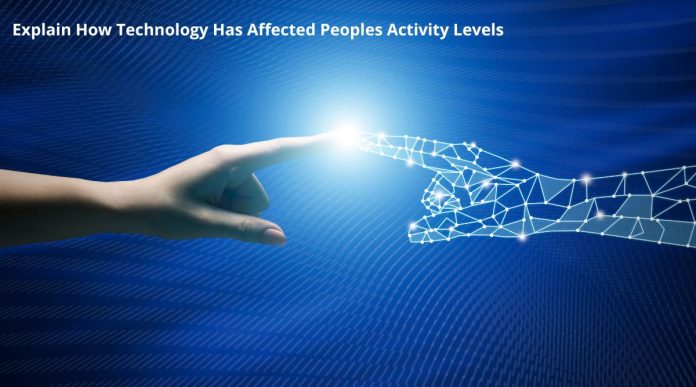The invention of technology has affected our lives in countless ways, but there are still many ways that it affects us that we might not have thought about before. Technology has been shown to have an effect on peoples activity levels and the way they use their time, but some experts think that technology actually encourages us to be more active than we otherwise would be. Technology-related physical activity has increased so much that the World Health Organization now recommends that we participate in at least two hours of moderate intensity physical activity per week. Here’s how technology affects our activity levels, and why it could potentially make us fitter.
How does Technologies has affected people’s activity levels actually among students?
Computer use and access to the internet has caused people to become more sedentary. Students are now less likely to get out of their chair during class because they can access any information they need on their desk top. Social networks, video games, and other interactive features all keep us glued to our screen, which keeps us in one place for hours on end. A recent study found that 82% of college students took zero physical education classes in a semester! Of those 82%, 43% say that video games have had a significant impact and another 23% said computer time has had a significant impact. Clearly technology is affecting activity levels. It may be convenient, but it’s not good for you.
To counteract this trend we recommend breaking up your day with periods of physical activity such as walking or even just standing up to talk with a friend who is sitting nearby. Take advantage of any breaks you might have throughout the day – whether it’s waiting in line at the bank or taking a bathroom break – by going outside and stretching your legs or just getting some fresh air. You’ll feel better and will probably be able to focus better too!
The Statistics
-19% of American teenagers are physically active for less than 60 minutes a day, which is below the national recommended guidelines
-Research suggests that sitting for too long can increase risk of cardiovascular disease, type 2 diabetes, some cancers and other conditions
-12% of adults in the United States are meeting recommendations for aerobic and muscle-strengthening exercise each week
-If you’re looking to get started on your health goal this year or pick up an exercise routine after a while of not doing anything at all, start small by making healthy choices every day that lead to big results over time. It may seem like nothing at first but before you know it you’ll be feeling healthier and more energized from head to toe!
Health Benefits of Fitness Devices
As with anything in life, the responsibility is yours to decide how and when you want to use technology. Since fitness devices are more of a supplement rather than a replacement for physical activity, we recommend finding a balance between the two. In addition to improving mood and increasing energy levels, getting more active can help improve sleep quality and reduce stress. We know that it’s not always easy! But by all means try to be aware of how you’re spending your time. When it’s tempting to check email or social media, take some time for yourself with some kind movement instead. Get up from your desk every hour and walk around for five minutes, even if it’s just down the hall. If you’re sitting at home and find yourself clicking on just one more show before bedtime, don’t worry! It’s better to read a few pages of something before bed then watch TV until midnight anyway. What about making an effort to get off of your phone while walking? Talking on the phone should also be kept to a minimum while exercising so we encourage talking less during walks or working out with friends instead.
Technology devices and apps
A recent study has shown that since 2008, human movement has declined by about 15%. People are now more sedentary and not being active enough due to the usage of technology devices. There is an app called, The Human Movement Project which analyzes the way people move, from walking to picking up something off the ground. It is a great way to track your movement throughout the day and find ways to be more active.
Another example of how technology can increase activity levels is simply looking at how people work out these days. In the past it was very common for someone to work out on a treadmill or just in their living room using TV timeouts as workout periods. Now with exercise DVDs, you have anywhere from 5-10 different workouts in one DVD. Not only do they take up less space than a bunch of different workout DVDs but also have multiple workouts you can choose from so you never get bored!
Wearable Fitness Device Types
In a time where obesity and sedentary lifestyles are on the rise, our world has created many different kinds of ways to monitor activity levels in order to combat these problems. The most common type of wearable fitness device is the Fitbit. This product connects to an app on your phone that can be synced with other accounts, such as Facebook or Runkeeper. This gives you a summary of your day and what activities you’ve done in addition to your steps walked, heart rate and sleep quality at night. Different types of wearable fitness devices may collect different information or they may all collect the same information just in different ways.
Conclusion
Since the invention of technology, people have changed their activity levels dramatically. For example, in the 1930s, children played outdoors on average 3.2 hours a day. Today, children spend less than an hour playing outside. It has also been reported that people watch 22% more TV today than they did 10 years ago. Many people are choosing to play games on smartphones instead of being active and having physical social interactions with others. This could result in declining health levels for people who use technology heavily due to a lack of physical activity and time with others without screens between them. One study found that kids who spent two hours or more each day watching TV were twice as likely to be obese by age seven as those who watched less than two hours per day. People need to start taking better care of themselves by getting enough sleep, eating healthy foods, staying physically active and spending time with other people in person rather than through digital means.

